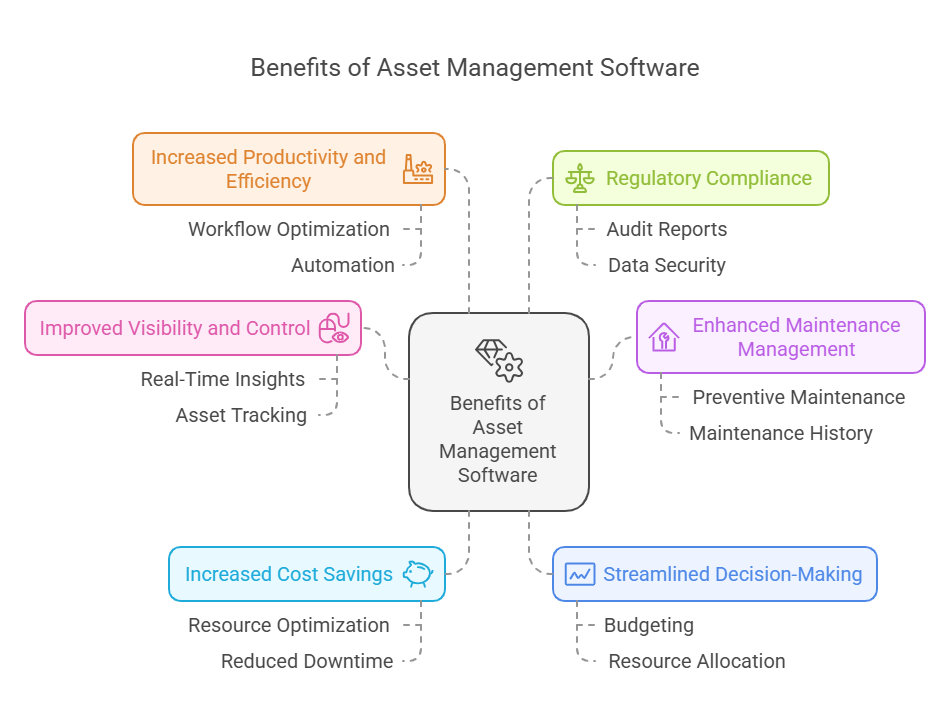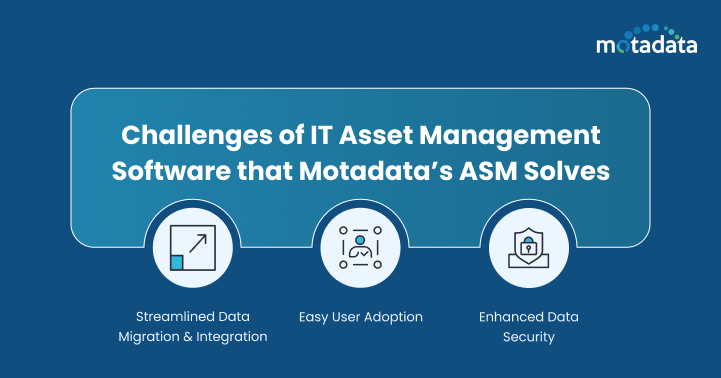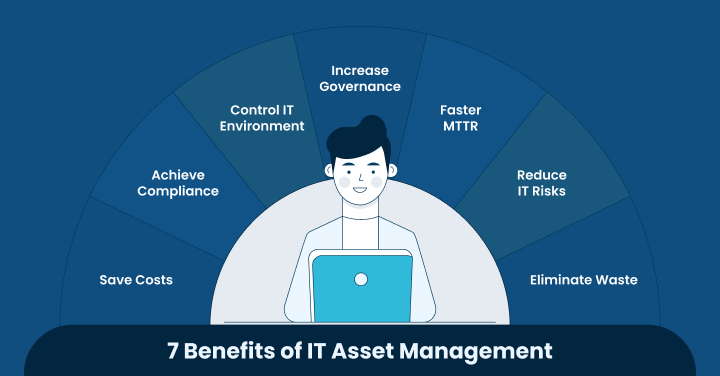The last few years have completely changed the dynamics of a business.
From entrepreneurs to technology leaders, each one of them has already reevaluated their priorities and is taking nothing for granted anymore, including their IT assets.
IT assets are crucial for many reasons, such as ensuring faster operations, offering robust data storage solutions, facilitating quick communication, risk mitigation, and offering customer support.
Hence, keeping track of assets and managing them is crucial to maximizing business value, cost management, and mitigating risks.
But with scaling businesses and increasing assets, maintaining, and tracking accurate status becomes quite challenging. This is where asset management software comes into play.
You cannot manually track all the assets of the entire organization using spreadsheets or ledger books as it is a daunting task.
Additionally, the chances of human error are higher with manual asset management.
Inaccurate data or missing information can result in downtime or excessive operational costs.
Hence, to prevent wrong decisions and better management of assets, it is best to invest in IT assets management software.
With the right IT hardware and software management tool in practice with all the key features, businesses can automatically track, monitor, and manage assets with minimal errors.
Whether you want to track your physical assets or digital assets, using this software, you can streamline all the processes and monitor your status from a central platform.
These best practices not only save you from the struggle of manual asset management but also offer several other benefits.
Let us discuss some of the key benefits of using asset management software and the challenges in detail.
What are the Benefits of Asset Management Software?
With proper usage of assets, businesses of all sizes can increase their total revenue over time.
Investing in modern practices rather than traditional manual methods to better manage assets is best.
Here are some of the key benefits of relying on modern asset management systems:
1. Improved Visibility and Control:
One of the main benefits of implementing asset management software into your business is it offers clear visibility into the status of all assets.
Further, the robust tool provides real-time insights into the location of each asset, its performance, and current condition for better decision-making and optimization.
With a comprehensive view and control over assets, businesses can find lost or misplaced assets faster and save valuable time on searching.
Even mobile app users can access its features to locate asset information on the go, thus improving productivity as well as efficiency levels.
Additionally, with improved visibility, all stakeholders can gain up-to-date information and lessen the risk of data inconsistency.
2. Enhanced Maintenance Management:
Another benefit of asset management systems is they help extend the lifespan of your assets.
Using this tool, IT teams can provide timely assistance and proper maintenance to each asset and avoid unnecessary costly breakdowns.
You can even schedule preventive maintenance, track each assent’s history and current status, and stop the problem from escalating or becoming critical.
Users can timely repair the assets with automated notifications and save on additional expenses.
By optimizing the maintenance resources it helps reduce downtime, improves performance, and prevents unnecessary overhead expenses.
3. Increased Cost Savings:
The ITAM software also contributes to cost savings by proper management and monitoring.
It ensures timely maintenance of all assets, helps minimize downtime, and prevents users from paying extra money for repairs and other expenses.
Additionally, it increases the life span of each asset, thus reducing frequent replacements.
Proactive maintenance also prevents issues from escalating, which helps make more efficient use of financial resources.
Also, with these tools, you can better manage your resource usage and make optimized procurement decisions.
4. Streamlined Decision-Making:
The insights generated by these tools can also be used to make better business decisions.
It provides updates on the assets that are underutilized or getting overutilized and accordingly optimizes their allocation.
Underutilized resources might also be responsible for unnecessary expenses. Hence, by figuring out these resources, you can save on costs.
Further, with accurate insights, businesses can set a good budget and forecast resource requirements.
5. Increased Productivity and Efficiency:
The powerful tool helps streamline your workflows by finding asset locations quickly and providing in-depth insights into their condition and faults.
The amount of time your employees had to earlier spend on searching and managing records is no longer needed, thanks to its excellent features.
The automation capability and real-time data access functionalities allow employees to work more on maximizing business value and improving efficiency.
These basic steps eventually result in improvement in productivity levels and an effective organization.
6. Regulatory Compliance:
Maintaining compliance and meeting regulatory requirements in different industries is crucial.
Asset management software aids businesses in achieving this goal by maintaining accurate and up-to-date records of all their physical and digital assets.
It provides detailed insights with audit reports to demonstrate compliance.
Additionally, it helps businesses have full control over the security of sensitive asset data and track changes in real-time, thus ensuring compliance with data protection standards.
Challenges of IT Asset Management Software that Motadata’s ASM Solves:
With some of the benefits, it also comes with a few challenges, including:
1. Streamlined Data Migration and Integration:
There is a high chance that you might have stored your asset information in different places and in different formats.
In such a case, migrating all your data into asset management solutions and consolidating them can be a challenging task.
Additionally, integrating the software with already existing software applications is another big challenge.
To ensure everything happens smoothly, you might have to pre-plan and coordinate with the team for smooth data exchange.
However, certain tools like Motadata can definitely help you in this case.
Motadata asset management software comes with various advanced features and integration capabilities that ease the whole task.
2. Easy User Adoption:
Another challenge that most businesses face is implementing the new software demands support.
Most team members have no clue about how to use the software and gain benefits from it. Hence, it requires proper training and support for effective utilization.
Initially, users may face a learning curve, but eventually, with the right training and documentation, businesses can overcome this challenge.
Motadata provides proper documentation and training support that helps users easily navigate and perform all tasks.
It even has an intuitive user interface that makes it easier for employees, even those with less experience, to adapt without any hassle.
3. Enhanced Data Security:
Maintaining data security is another challenge that most businesses have to go through when implementing asset management software.
Since the software collects all the critical information related to assets for better management, there are chances of misuse or data loss.
Hence, ensuring data security is highly critical for the tool to store all updates related to the software license, contact details, and even maintenance history.
Make sure the tool you select for IT asset management offers robust security options that prevent critical information from getting leaked to unauthorized users.
Additionally, you must set protocols and strict guidelines for the security of your assets, as well as permissions that allow only specific users to access the details.
Motadata is one such tool that comprises all these capabilities and offers full-time security for your data.
From encryption to maintaining compliance, the software covers everything in its package.
Examples of How Different Industries Use Asset Management Systems
Several industries exercise IT asset management software to streamline their operations and improve efficiency levels.
Here are a few examples that demonstrate how different industries use asset management software:
Real Estate:
There are several individuals and companies that often invest in the real estate business. They purchase property at a decent price and later resell it for profit.
Many investors use Driving for Dollars to find profitable opportunities by scouting neighborhoods for undervalued properties.
In some cases, companies even lease out or rent the purchased property for greater returns. It is a complex sector with high returns if managed properly.
You cannot manage this sector through traditional practices. Instead, you must invest in asset management tools to maximize property value and returns.
This software helps real estate professionals properly track their properties, equipment, and maintenance schedules.
The insights collected by the tool help such companies comply with regulations and better manage their assets
Healthcare:
Even hospitals and healthcare sectors rely on this software to maintain proper track of medical equipment and inventory and ensure compliance with regulatory standards.
Several medical tools and supplies are ordered daily.
Some are not even used regularly, but constantly adding them to the buying list will automatically result in unnecessary costs.
Hospitals can avoid such cost management issues by properly tracking resources, their use, and requirements.
Investing in asset management systems allows teams to monitor equipment usage and accordingly manage demand.
Further, this software allows management teams to better streamline different processes, automate various tasks, and get in-depth insights into the entire facility’s operations, thus addressing issues before they escalate.
Manufacturing:
Even the manufacturing sector can benefit from IT solutions for manufacturing to optimize asset management and boost profitability.
It allows professionals to track inventory, manage spare parts usage, and save on operational costs.
Further, these insights help improve the lifespan of assets. It even allows manufacturing teams to schedule maintenance effectively and reduce unnecessary repair costs.
Additionally, you can generate detailed reports on predicted depreciation and replacement costing with this powerful tool.
Conclusion
From small businesses to large organizations, each of them uses assets to run operations smoothly.
It can be available in physical forms or digital, depending on the needs of your organization.
Also, the larger your business, the more your assets will be.
In such a case, managing your assets without proper tools and solutions can be quite challenging.
Manual asset tracking won’t be enough for a complex environment.
Hence, investing in asset management tools that provide detailed reports on asset performance, inventory management, and more is best.
These tools help businesses better optimize their asset utilization, manage costs, and streamline all management processes.
They also help overcome common data security, data migration, and other challenges.
In fact, today, most industries, including healthcare, real estate, and manufacturing, have already started using this software to expand their asset lifecycles and improve productivity.
Technologies are constantly evolving, and so will the use of asset management in the coming period, so make sure to stay prepared by investing in the best asset management software today.
Get a free trial for some of the top asset management software like Motadata and overcome common business challenges.
FAQs
The ITAM software provides a centralized platform for examining the status and condition of each asset in real-time. It aids businesses in monitoring and managing assets effectively and saves a lot of time and money. This robust tool can also ensure compliance, optimize resource usage, and make more informed decisions.
Asset management software provides real-time visibility into asset performance, usage, and maintenance schedules, enabling businesses to analyze their actual status more effectively. It also helps track underutilized resources and implement essential practices to manage their usage and make better decisions.
This software allows you to track hardware assets like equipment, machinery, laptops, computer systems, mobile devices, and digital assets. It even allows employees to track software assets, inventory, contracts, and licenses using different methods.
Asset management software enhances asset security and risk management by providing businesses with the tools and capabilities required to securely store and handle asset data.
It ensures compliance with data security regulations, limits access to personal information, and enables effective risk management through proactive monitoring and reporting. It facilitates contact with service providers and ensures compliance with service-level agreements while reducing risks.








